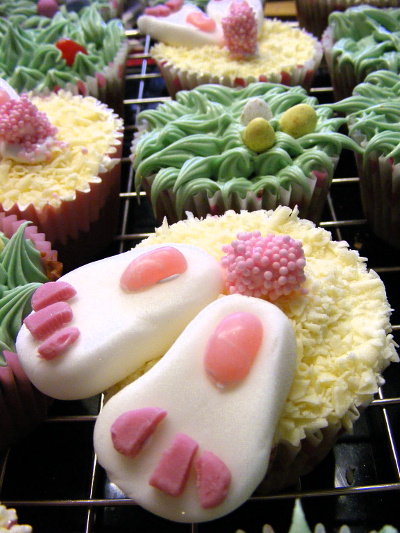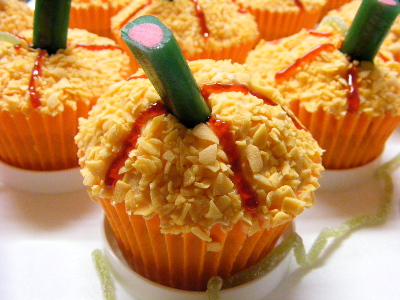 Full Title: Hello, Cupcake!: Irresistibly Playful Creations Anyone Can Make
Full Title: Hello, Cupcake!: Irresistibly Playful Creations Anyone Can Make
First Published: 24th April, 2008
Genre: Cookery Non-Fiction
Available: Amazon.com | Amazon UK
This is a book about decorating cupcakes. The designs tend towards the whimsical, with cute critters, cakes that look like other food, and similar things. I can’t fault the layout of the book, as it’s very clear. There are decent photographs of each design and templates for shaped parts where needed. The opening explains basics like how to ice in different ways and how to turn a food bag into an icing bag. However, the proof in the pudding (or cake) is trying the instructions, which is what I’ll focus on in the rest of the review.
My first attempt was the design called “Rabbit Holes”. These are the back ends of rabbits, placed among other cupcakes that look like grass. I tweaked the design a little, as it used crunched up chocolate biscuits for the bunny fur. One of the family doesn’t like chocolate biscuits and I don’t eat crunchy textures. So I swapped that out for white chocolate curls, and made white/pink Easter bunnies instead.
An issue that came up in the preparations is this is an American book and I live in the UK. The feet of the rabbits were circus peanuts, which is something I’ve never seen here. I used fondant icing and shaped my own bunny feet as an alternative. Corn syrup, used to stick the bobbles on the bunny tail, is also not a UK product, but that’s quite often available in the import section of supermarkets. I did use corn syrup, but would have got the same result with a little basic icing (icing sugar and water). This would also avoid buying an item when such a small amount was needed.
Overall, this is a very forgiving design. The sprinkles to make the rabbit fur hide any mess in the icing below. The iced grass cakes can be messy without it looking bad, as grass doesn’t have to follow any set pattern. I found the instructions clear, and it wasn’t difficult to modify as needed.

Image Caption: Rabbit and grass cupcakes. The rabbit cakes are the back end of a bunny, with white chocolate curls as fur. A bobble tail (coated in pink nonpareils) is in the centre of the bunny cakes, with two back feet made of white fondant icing and pink chocolate details sticking over the edge of each cake. Around them are grass cupcakes, with piped green buttercream, and jelly beans and chocolate eggs on the grass.
I also tried the “Pumpkin Patch” design. The base cupcakes baked flat (more on that later), so mounding the icing as described was a challenge. I wasn’t happy with the result. My usual cupcake recipe would likely rise better, making the mounding process easier, and meaning it wouldn’t require too much icing to achieve.
Another problem with the pumpkins was the writing icing I used didn’t really match the orange of the chocolate curls I used to coat the pumpkins. This was a supply issue rather than being anyone’s fault, but not being able to get the right colours matters a lot more with this design. There isn’t as much room to use different colours or tweak the design.
All that said, the family thought they were good, so it wasn’t a complete disaster. But designs like the rabbit holes are much more forgiving when it comes to having to use alternate items.

Image Caption: Pumpkin cupcakes. Orange cupcake cases contain mounded cakes covered in orange chocolate curls. Darker orange icing marks out the segments of the pumpkin. A piece of green liquorice with a pink centre is on top as a stalk.
I’d say the ease of the designs is going to depend on how easy it is to get the items used. Americans will find it a lot easier to follow the instructions. Even there, the claim that anyone can make these is an exaggeration, as it does take a bit of skill to get a cake looking reasonable. I also think some of the designs would be daunting to a beginner, as they used so many different items. Some of these could be simplified down and still look and taste fine.
Though this is mainly a decorating book, there are a few cupcake recipes. I’d note my standard recipe for cupcakes is to use equal amounts of self-raising flour, sugar and butter, with an egg or two. The recipes in this book were somewhat different. Partly due to cultural differences, as self-raising flour isn’t a thing everywhere, so it uses plain flour with raising agents added. However, some of the differences didn’t make very good cakes, in my opinion.
Vanilla cupcakes are a staple in my family, as they are one of the few that everyone likes. The recipe here uses butter and vegetable oil. The latter turned out to be an issue. It made the cake mix very runny, which was harder to handle. The cakes baked very flat, which wasn’t good for the pumpkin cakes, and meant they weren’t as fluffy. Also, the oil leached into standard paper cases, which didn’t look very good. They need thicker cases or foiled cases to work. There can be a bit of this with any cupcake baking, but it was much more pronounced using vegetable oil.
I sort of tried the lemon poppy-seed cupcakes, but I altered the recipe before using it. This is because the only lemon included is a bit of grated peel. This recipe is something I’d expect at fancy restaurants, where stuff only tastes of a hint of whatever it is, because bland is fashionable. With my whole working class upbringing thing, I like my lemon cake to actually taste of lemons, so I swapped the cream cheese for lemon curd.
I didn’t feel inspired to try the other cupcake recipes. I did try the almost-homemade vanilla buttercream, but it’s a little strange that it uses marshmallow fluff. Buttercream is very simple to make from scratch. This takes that and makes it more complicated. Which is a comment I’d have with a number of the recipes. It was interesting to try the variations, but they aren’t what I’d give a beginner, and I didn’t notice any improvement in taste or texture for the extra hassle.
When it comes to cake decorating, there’s a lot to like in this book. There are many cute designs, which can act as inspiration even if they’re not directly followed. It explains basics like how to ice things, and I particularly liked the tip of using food bags as an icing bag. I do think there’s a bit of a mismatch in places between the intended beginner audience and the complexity of the projects. Also, the recipes are something I’d skip.